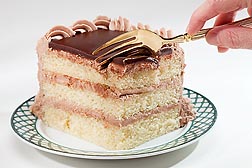Better White Layer Cakes Ahead?
Experiments led by Agricultural Research Service food technologist Mukti Singh are showing how to boost the fiber content in white layer cake—or lower the calories—without significantly undermining many of the key qualities of this all-time-favorite dessert.
Singh’s edible-fiber experiments focused on corn bran, the corn kernel’s fiber-rich outer layer. She determined that purified, finely ground corn bran can be used as a substitute for up to 20 percent of the flour called for in the American Association of Cereal Chemists’ “gold standard” test recipe for white cake. That amount of fiber didn’t significantly affect qualities such as color, crumb grain size (an indicator of structure), volume, moisture (moist—but not soggy—is ideal), and springiness (the unfrosted top surface of a good cake will spring back when gently touched).
What’s more, the 25 volunteer taste-testers who sampled the 20-percent-corn-bran-enhanced cake rated it as “acceptable.” In taste-tester lingo, that counts as a vote of confidence.
Singh estimates that one slice of an 8-inch, six-slice, two-layer white cake made with that amount of bran would provide about 5 grams of healthful fiber. A slice from a standard white layer cake would provide about 1 gram.
A peer-reviewed scientific article that Singh and colleagues Steven F. Vaughn and Sean X. Liu, all with the ARS National Center for Agricultural Utilization Research in Peoria, Illinois, published in 2012 in Biocatalysis and Agricultural Biotechnology has details that may interest bakers and companies that make cake mixes for commercial or home baking.
The study is apparently among the few that provide publicly accessible data about the effects that relatively high concentrations of purified, finely ground corn bran can have on the quality of white cake.
In tests aimed at cutting calories—without sacrificing quality—Singh worked with a patented, ARS-developed process that uses steam-jet cooking to encapsulate microdroplets of cooking oil (in this case, canola) with flour and water. The cream-textured mixture that results can then be dried to form a smooth-flowing, shelf-stable powder that’s ready for the mixing bowl.
Explains Singh, “Encapsulation helps distribute the oil evenly throughout the cake, so you can use less of it and still have some of the smooth mouthfeel of a higher oil, higher calorie cake.” And the approach offers busy bakers the convenience of having oil already included in the mix, so there’s no need for pouring, measuring, or cleanup of this ingredient.
In these tests, Singh used only 25 percent of the cooking oil called for in the standard test recipe. She showed that cakes made with the flour-oil-water “composites” were softer and springier, and stayed moist longer, than cakes made with the same amount of nonencapsulated flour and oil.
Noted briefly in Agricultural Research in March 2010, the work was reported in detail in the Journal of Food Processing and Technology in 2012. The study presents what is likely the first data, published in a scientific research journal, about use of the composites in cake. The findings provide a foundation for further research and development, including taste-testing.—By Marcia Wood, Agricultural Research Service Information Staff.
This research is part of Quality and Utilization of Agricultural Products, an ARS national program (#306) described at www.nps.ars.usda.gov.
Mukti Singh is with the USDA-ARS National Center for Agricultural Utilization Research, Functional Foods Research Unit, 1815 N. University St., Peoria, IL 60605; (309) 681-6357.
"Better White Layer Cakes Ahead" was published in the November/December 2013 issue of Agricultural Research magazine.







